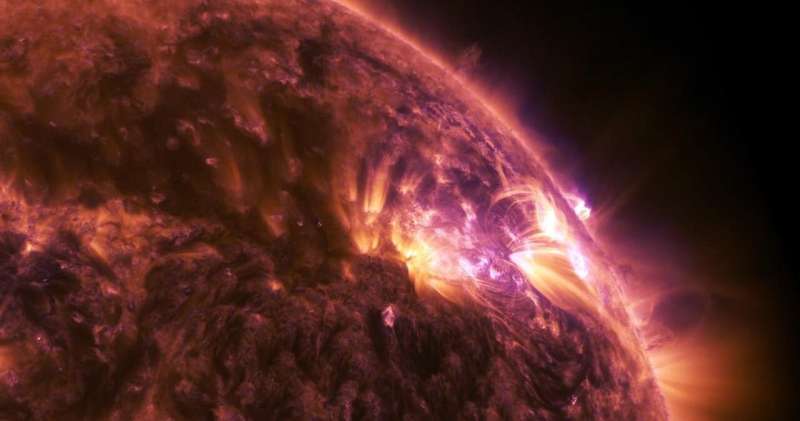Scientists reproduce the dynamics behind astrophysical shocks

High-energy shock waves driven by solar flares and coronal mass ejections of plasma from the sun erupt throughout the solar system, unleashing magnetic space storms that can damage satellites, disrupt cell phone service and blackout power grids on Earth. Also driving high-energy waves is the solar wind—plasma that constantly flows from the sun and buffets the Earth's protective magnetic field.
Now experiments led by researchers at the U.S. Department of Energy's (DOE) Princeton Plasma Physics Laboratory (PPPL) in the Princeton Center for Heliophysics have for the first time reproduced the process behind the source of such shocks. The findings bridge the gap between laboratory and spacecraft observations and advance understanding of how the universe works.
Sudden jumps
The experiments, reported in Physical Review Letters, show how the interaction of plasma—the state of matter composed of free electrons and atomic nuclei, or ions—can cause sudden jumps in plasma pressure and magnetic field strength that can accelerate particles to near the speed of light. Such shocks are "collisionless" because they are formed by the interaction of waves and plasma particles rather than by collisions between the particles themselves.
The research produced measurement of the full run-up to shocks. "Direct measurement is an elegant way to see how the particles are moving and interacting," said physicist Derek Schaeffer of PPPL and Princeton University, who led the research. "Our paper shows that we can employ a powerful diagnostic to study the particle motions that lead to shocks."
The research, conducted on the Omega laser facility at the University of Rochester, produced a laser-driven plasma—called a "piston" plasma—that expanded at the supersonic rate of more than one million miles per hour through a pre-existing ambient plasma. The expansion accelerated ions in the ambient plasma to speeds of roughly half-a-million miles per hour, simulating the forerunner to collisionless shocks that occur throughout the cosmos.
The research unfolded in several stages:
- First, creation of the piston plasma reproduced the supersonic plasmas that form in outer space. The piston acted like a snowplow, sweeping up ions in the ambient plasma embedded in a magnetic field.
- As more of these ions became swept up, they formed a barrier that kept the piston from acting further. "Once you've piled up enough 'snow', the shock decouples from the piston," Schaeffer said.
- The halted piston handed off formation of the shock to the highly compressed magnetized plasma, which gave rise to the sudden collisionless jump.
Researchers used a diagnostic called Thompson scattering to track these developments. The diagnostic detects laser light scattered off the electrons in plasma, enabling measurement of the temperature and density of the electrons and the speed of the flowing ions. The results, the authors write, show that laboratory experiments can probe the behavior of plasma particles in the precursor to collisionless astrophysical shocks, "and can complement, and in some cases overcome the limitations of similar measurements undertaken by spacecraft missions."
Ultimate goal
While this research reproduced the process that sets off shocks, the ultimate goal is to measure the shock-accelerated particles themselves. For that step, said Schaeffer, "the same diagnostic can be used once we develop the capability to drive strong enough shocks. As a bonus," he adds, "this diagnostic is similar to how spacecraft measure particle motions in space shocks, so future results can be directly compared."
More information: D. B. Schaeffer et al, Direct Observations of Particle Dynamics in Magnetized Collisionless Shock Precursors in Laser-Produced Plasmas, Physical Review Letters (2019). DOI: 10.1103/PhysRevLett.122.245001
Journal information: Physical Review Letters
Provided by Princeton Plasma Physics Laboratory





















